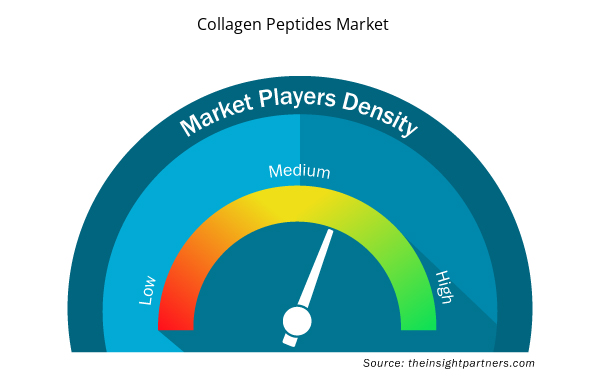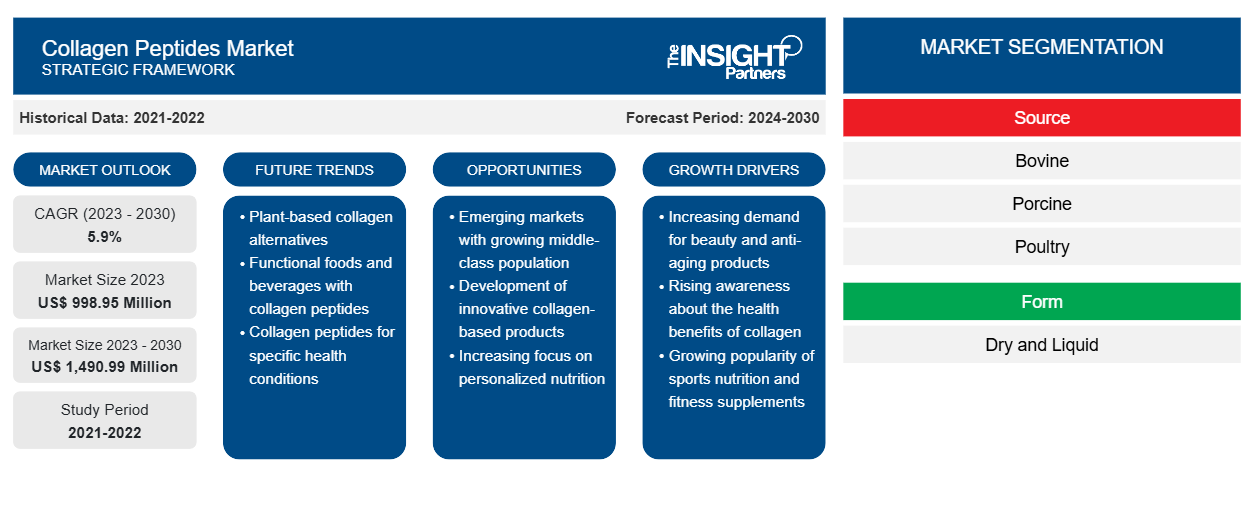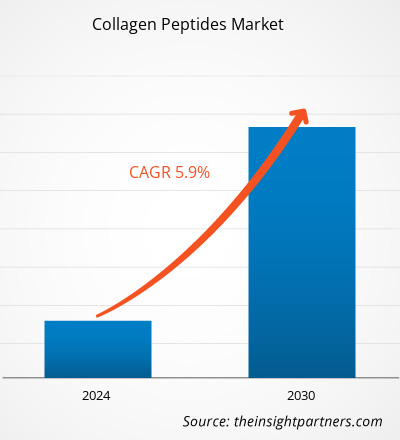[研究报告] 2023 年胶原蛋白肽市场价值为 9.9895 亿美元,预计到 2030 年将达到 14.9099 亿美元;预计 2023 年至 2030 年的复合年增长率为 5.9%。
全球胶原蛋白肽市场竞争激烈,大量本地、区域和全球制造商在产品质量和创新方面展开竞争。一些胶原蛋白肽制造商已获得犹太洁食和清真认证,增强了其在全球市场的竞争地位。例如,重要的胶原蛋白制造商之一 Rousselot 拥有清真和犹太洁食认证的生产部门。此外,该公司还获得了 IFS、ISO 9001、GMP+ 和 FCA 认证,增强了其市场地位。制造商还投资于产品创新和新产品开发,以满足不断变化的客户偏好。例如,Evonik Industries Inc. 最近使用发酵工艺推出了纯素食胶原蛋白。这些举措预计将为全球胶原蛋白肽市场的制造商提供丰厚的机会
2022 年,北美占据全球胶原蛋白肽市场的最大份额,而亚太地区预计在预测期内的复合年增长率最高。胶原蛋白肽用于各种补充剂形式,例如粉末、胶囊和片剂以及软糖等。该地区对营养保健品的需求旺盛,主要推动了胶原蛋白肽的销售。因此,营养美容 行业越来越多地加入胶原蛋白肽来满足消费者的需求。此外,胶原蛋白肽对骨萎缩、骨密度降低和骨稳定性有效。因此,广泛的应用范围正在推动整个地区对胶原蛋白肽的需求。
定制此报告以满足您的需求
您可以免费定制任何报告,包括本报告的部分内容、国家级分析、Excel 数据包,以及为初创企业和大学提供优惠和折扣
- 获取此报告的关键市场趋势。这个免费样品将包括数据分析,从市场趋势到估计和预测。
COVID-19 疫情对胶原蛋白肽市场的影响
功能性食品和饮料产品、膳食补充剂的消费量不断增长,以及对富含蛋白质产品的需求旺盛,是推动胶原蛋白肽市场在 COVID-19 疫情爆发前增长的关键因素。然而,这些行业在 2020 年疫情爆发后面临着前所未有的挑战。
2021 年,随着多个国家的政府宣布放宽先前实施的限制,各个经济体恢复运营,这提振了全球市场。此外,制造商被允许满负荷运营,这有助于他们克服供需缺口和其他影响。随着许多国家的众多公民在 2021 年之前完全接种疫苗,胶原蛋白肽制造商专注于增加产量以重振业务。
市场洞察
海洋胶原蛋白肽需求激增,推动胶原蛋白肽市场增长
鱼类、水母、海绵动物和其他无脊椎动物等海洋生物是胶原蛋白肽的重要来源。它们比其他来源更具优势,因为它们具有代谢兼容性、不受宗教约束且不含动物病原体。此外,海洋来源的胶原蛋白肽由于其水溶性和代谢兼容性可用作生物材料。因此,随着不同工业应用的利用率不断提高,对海洋来源胶原蛋白肽的需求也在增加。
此外,海洋胶原蛋白肽不会传播传染病。陆地动物具有许多传染病,因此不太适合工业用途。例如,牛虽然是胶原蛋白的主要来源,但也存在 BSE 和 TSE 的风险。这些因素使海洋胶原蛋白肽成为一种更简单、更安全、更有前景的替代品。因此,随着需求的增加,制造商正在推出不同的产品。例如,2021 年 1 月,Darling Ingredients 推出了 Rousselot 品牌下的海洋胶原蛋白肽 Peptan。该产品帮助该公司进入膳食补充剂市场。因此,预计在预测期内,对海洋胶原蛋白的需求不断增长将为胶原蛋白肽市场带来新的机会。
基于来源的洞察
根据来源,胶原蛋白肽市场分为牛、猪、家禽、海洋和其他。牛部分在 2022 年占据了最大的市场份额,而海洋部分在预测期内增长最快。海洋胶原蛋白肽主要来自不同的鱼类、水母和海绵。因此,作为牛和猪的替代品,对海洋来源的胶原蛋白肽的需求正在增加,预计这将影响胶原蛋白肽市场的增长。
基于应用的洞察
根据应用,胶原蛋白肽市场细分为食品和饮料、药品和保健品、个人护理等。食品和饮料部门预计在预测期内的复合年增长率最高。在乳制品中,它用作质地和稳定剂。胶原蛋白水解物可以附着钙离子,提高其生物利用度。因此,胶原蛋白肽可用于功能性食品成分以管理矿物质缺乏症。
胶原蛋白肽对需要在低温或冷冻温度下储存的食品有益,因为它可以作为抗凝剂,有助于减少细胞和组织的损伤。胶原蛋白肽有助于提高和维持产品的感官、物理和化学特性。因此,由于上述特性,胶原蛋白肽已用于制备肉类、饮料和汤等不同产品。
胶原蛋白肽市场的主要参与者包括 GELITA AG、Rousselot BV、Titan Biotech Ltd、Tessenderlo Group NV、Ewald-Gelatine GmbH、BioCell Technology LLC、Lapi Gelatine SpA、Weishardt Holding SA、Nippi Collagen NA Inc 和 Nitta Gelatin India Ltd。这些公司专注于新产品的推出和地域扩张,以满足全球日益增长的消费者需求,并增加其专业产品组合的产品范围。它们在全球拥有广泛的业务,这使它们能够服务于大量客户,从而增加其市场份额。
胶原蛋白肽市场区域洞察
Insight Partners 的分析师已详细解释了预测期内影响胶原蛋白肽市场的区域趋势和因素。本节还讨论了北美、欧洲、亚太地区、中东和非洲以及南美和中美洲的胶原蛋白肽市场细分和地理位置。

- 获取胶原蛋白肽市场的区域特定数据
胶原蛋白肽市场报告范围
| 报告属性 | 细节 |
|---|---|
| 2023 年的市场规模 | 9.9895亿美元 |
| 2030 年的市场规模 | 14.9099亿美元 |
| 全球复合年增长率(2023 - 2030 年) | 5.9% |
| 史料 | 2021-2022 |
| 预测期 | 2024-2030 |
| 涵盖的领域 | 按来源
|
| 覆盖地区和国家 | 北美
|
| 市场领导者和主要公司简介 |
|
胶原蛋白肽市场参与者密度:了解其对业务动态的影响
胶原蛋白肽市场正在快速增长,这得益于终端用户需求的不断增长,而这些需求又源于消费者偏好的不断变化、技术进步以及对产品优势的认识不断提高等因素。随着需求的增加,企业正在扩大其产品范围,进行创新以满足消费者的需求,并利用新兴趋势,从而进一步推动市场增长。
市场参与者密度是指在特定市场或行业内运营的企业或公司的分布情况。它表明在给定市场空间中,相对于其规模或总市场价值,有多少竞争对手(市场参与者)存在。
在胶原蛋白肽市场运营的主要公司有:
- 嘉利达公司
- 罗赛洛公司
- 泰坦生物科技有限公司
- Tessenderlo 集团
- Ewald-Gelatine 有限公司
免责声明:上面列出的公司没有按照任何特定顺序排列。

- 了解胶原蛋白肽市场顶级关键参与者概况
报告亮点
- 胶原蛋白肽市场的渐进式行业趋势有助于企业制定有效的长期战略
- 发达国家和发展中国家市场参与者采用的业务增长战略
- 2022 年至 2030 年市场定量分析
- 全球胶原蛋白肽需求量估计
- 波特五力分析说明胶原蛋白肽市场中买家和供应商的效力
- 了解竞争市场状况的最新发展
- 胶原蛋白肽市场的市场趋势和前景以及增长动力和限制因素
- 通过强调支撑商业利益的市场策略来协助决策过程
- 胶原蛋白肽市场不同节点的规模
- 胶原蛋白肽行业详细概述和动态
- 各地区胶原蛋白肽市场规模及增长潜力
- 历史分析(2 年)、基准年、预测(7 年)及复合年增长率
- PEST 和 SWOT 分析
- 市场规模价值/数量 - 全球、区域、国家
- 行业和竞争格局
- Excel 数据集



Report Coverage
Revenue forecast, Company Analysis, Industry landscape, Growth factors, and Trends

Segment Covered
This text is related
to segments covered.

Regional Scope
North America, Europe, Asia Pacific, Middle East & Africa, South & Central America

Country Scope
This text is related
to country scope.
常见问题
Based on source, bovine segments mainly have the largest revenue share. Bovine-based collagen peptide is a common food additive and supplement. It is primarily extracted from cows. The consumption of bovine collagen helps improve skin health and prevent bone loss. The body’s collagen production naturally decreases with age, and the deficiency can cause health issues related to bone, joints, and skin. Individuals exposed to excess sunlight are also at risk of decreased collagen production. Bovine collagen peptides supplements may help counter the effects of low collagen levels. Boiling cow bones or other cattle byproducts in water produces this collagen type. After the collagen is extracted in an aqueous solution, it is dried and powdered to form a final product. Bovine collagen has been found to improve Type I and III collagen levels in the human body. The skin is primarily built up of Types I and III collagen; thus, its intake in specified quantities helps reduce wrinkles, promote elasticity, and increase skin moisture.
The major players operating in the global collagen peptides market are GELITA AG, Rousselot BV, Titan Biotech Ltd, Tessenderlo Group NV, Ewald-Gelatine GmbH, BioCell Technology LLC, Lapi Gelatine SpA, Weishardt Holding SA, Nippi Collagen NA Inc, and Nitta Gelatin India Ltd.
Surging Demand for marine-sourced collagen peptides to provide potential market opportunities in the coming years for the collagen peptides. Marine organisms such as fish, jellyfish, sponges, and other invertebrates harbor a significant source of collagen peptides. They are highly advantageous over other sources, as they are metabolically compatible, lack religious constraints, and are free of animal pathogens. Marine-sourced collagen peptide is majorly used for skincare product manufacturing. It is a versatile compound capable of healing skin injuries of varying severity and delaying the natural human aging process. Moreover, marine-sourced collagen peptides can be used as a biomaterial owing to its water solubility and metabolic compatibility. Thus, the demand for marine-sourced collagen peptide is increasing with its rising utilization for different industrial applications.
North America accounted for the largest share of the global collagen peptides market. Collagen peptide-based supplements are becoming increasingly popular, particularly for the prevention and treatment of arthritis. Geriatric population of North America are opting for bone and joint health supplements to improve and maintain their health and well-being. According to the Centers for Disease Control and Prevention (CDC), November 3, 2021 report, ~54 million people in the US were diagnosed with severe joint pain caused by arthritis. In the US, 24% of all adults, or 58.5 million people, have arthritis. Owing to the high frequency of arthritis, collagen peptide-based supplements for bone and joint health are in high demand in North America.
Based on the application, food and beverages segment is projected to grow at the fastest CAGR over the forecast period. Collagen peptides are used in various food and beverages such as dairy products, confectioneries, and beverages. It improves the chewiness, foam stabilization, and texture of confectioneries. Additionally, in dairy products, it is used as a texturization and stabilization agent. Collagen peptides act as a binding agent for ingredients used in nutritional bars, enhancing their softness. As a result of increased health consciousness, food manufacturers prefer collagen peptides to develop nutritious food products. Collagen hydrolysates can attach calcium ions, improving their bioavailability. Thus, collagen peptides can be used in functional food ingredients to manage mineral deficiencies.
Strategic development initiatives by key market players are driving the collagen peptides market. Various end-use industries are adopting business expansion strategies and scaling production capacity to provide better customer satisfaction. For instance, in July 2020, Rousselot and Giusto Faravelli announced a distribution partnership in Italy, effective from October 2020. Under this partnership, Faravelli distributes food and pharmaceutical gelatins, hydrolyzed collagens, and biomedical gelatins across Italy. Thus, expanding businesses to other regions or countries to cater to the increasing demand by consumers drives the market growth. Such development strategies by collagen peptide manufacturers extend their reach and gain a competitive edge in international markets.
Trends and growth analysis reports related to Food and Beverages : READ MORE..
The List of Companies - Collagen Peptides Market
- GELITA AG
- Rousselot BV
- Titan Biotech Ltd
- Tessenderlo Group NV
- Ewald-Gelatine GmbH
- BioCell Technology LLC
- Lapi Gelatine SpA
- Weishardt Holding SA
- Nippi Collagen NA Inc
- Nitta Gelatin India Ltd.
The Insight Partners performs research in 4 major stages: Data Collection & Secondary Research, Primary Research, Data Analysis and Data Triangulation & Final Review.
- Data Collection and Secondary Research:
As a market research and consulting firm operating from a decade, we have published and advised several client across the globe. First step for any study will start with an assessment of currently available data and insights from existing reports. Further, historical and current market information is collected from Investor Presentations, Annual Reports, SEC Filings, etc., and other information related to company’s performance and market positioning are gathered from Paid Databases (Factiva, Hoovers, and Reuters) and various other publications available in public domain.
Several associations trade associates, technical forums, institutes, societies and organization are accessed to gain technical as well as market related insights through their publications such as research papers, blogs and press releases related to the studies are referred to get cues about the market. Further, white papers, journals, magazines, and other news articles published in last 3 years are scrutinized and analyzed to understand the current market trends.
- Primary Research:
The primarily interview analysis comprise of data obtained from industry participants interview and answers to survey questions gathered by in-house primary team.
For primary research, interviews are conducted with industry experts/CEOs/Marketing Managers/VPs/Subject Matter Experts from both demand and supply side to get a 360-degree view of the market. The primary team conducts several interviews based on the complexity of the markets to understand the various market trends and dynamics which makes research more credible and precise.
A typical research interview fulfils the following functions:
- Provides first-hand information on the market size, market trends, growth trends, competitive landscape, and outlook
- Validates and strengthens in-house secondary research findings
- Develops the analysis team’s expertise and market understanding
Primary research involves email interactions and telephone interviews for each market, category, segment, and sub-segment across geographies. The participants who typically take part in such a process include, but are not limited to:
- Industry participants: VPs, business development managers, market intelligence managers and national sales managers
- Outside experts: Valuation experts, research analysts and key opinion leaders specializing in the electronics and semiconductor industry.
Below is the breakup of our primary respondents by company, designation, and region:

Once we receive the confirmation from primary research sources or primary respondents, we finalize the base year market estimation and forecast the data as per the macroeconomic and microeconomic factors assessed during data collection.
- Data Analysis:
Once data is validated through both secondary as well as primary respondents, we finalize the market estimations by hypothesis formulation and factor analysis at regional and country level.
- Macro-Economic Factor Analysis:
We analyse macroeconomic indicators such the gross domestic product (GDP), increase in the demand for goods and services across industries, technological advancement, regional economic growth, governmental policies, the influence of COVID-19, PEST analysis, and other aspects. This analysis aids in setting benchmarks for various nations/regions and approximating market splits. Additionally, the general trend of the aforementioned components aid in determining the market's development possibilities.
- Country Level Data:
Various factors that are especially aligned to the country are taken into account to determine the market size for a certain area and country, including the presence of vendors, such as headquarters and offices, the country's GDP, demand patterns, and industry growth. To comprehend the market dynamics for the nation, a number of growth variables, inhibitors, application areas, and current market trends are researched. The aforementioned elements aid in determining the country's overall market's growth potential.
- Company Profile:
The “Table of Contents” is formulated by listing and analyzing more than 25 - 30 companies operating in the market ecosystem across geographies. However, we profile only 10 companies as a standard practice in our syndicate reports. These 10 companies comprise leading, emerging, and regional players. Nonetheless, our analysis is not restricted to the 10 listed companies, we also analyze other companies present in the market to develop a holistic view and understand the prevailing trends. The “Company Profiles” section in the report covers key facts, business description, products & services, financial information, SWOT analysis, and key developments. The financial information presented is extracted from the annual reports and official documents of the publicly listed companies. Upon collecting the information for the sections of respective companies, we verify them via various primary sources and then compile the data in respective company profiles. The company level information helps us in deriving the base number as well as in forecasting the market size.
- Developing Base Number:
Aggregation of sales statistics (2020-2022) and macro-economic factor, and other secondary and primary research insights are utilized to arrive at base number and related market shares for 2022. The data gaps are identified in this step and relevant market data is analyzed, collected from paid primary interviews or databases. On finalizing the base year market size, forecasts are developed on the basis of macro-economic, industry and market growth factors and company level analysis.
- Data Triangulation and Final Review:
The market findings and base year market size calculations are validated from supply as well as demand side. Demand side validations are based on macro-economic factor analysis and benchmarks for respective regions and countries. In case of supply side validations, revenues of major companies are estimated (in case not available) based on industry benchmark, approximate number of employees, product portfolio, and primary interviews revenues are gathered. Further revenue from target product/service segment is assessed to avoid overshooting of market statistics. In case of heavy deviations between supply and demand side values, all thes steps are repeated to achieve synchronization.
We follow an iterative model, wherein we share our research findings with Subject Matter Experts (SME’s) and Key Opinion Leaders (KOLs) until consensus view of the market is not formulated – this model negates any drastic deviation in the opinions of experts. Only validated and universally acceptable research findings are quoted in our reports.
We have important check points that we use to validate our research findings – which we call – data triangulation, where we validate the information, we generate from secondary sources with primary interviews and then we re-validate with our internal data bases and Subject matter experts. This comprehensive model enables us to deliver high quality, reliable data in shortest possible time.


 获取此报告的免费样本
获取此报告的免费样本